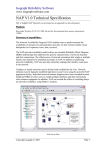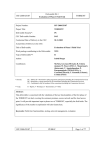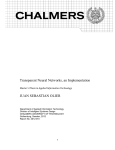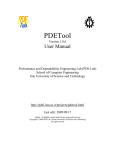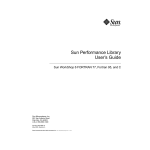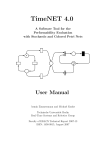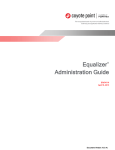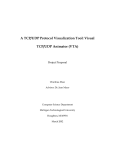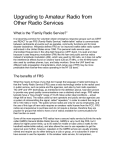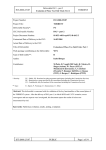Download An Unavailability Analysis of Firewall Sandwich Configurations
Transcript
An Unavailability Analysis of Firewall Sandwich Configurations Steve Goddard Computer Science & Engineering University of Nebraska – Lincoln Lincoln, NE 68588-0115 [email protected] Abstract Firewalls form the first line of defense in securing internal networks from the Internet. A Firewall only provides security if all traffic into and out of an internal network passes through the firewall. However, a single firewall through which all network traffic must flow represents a single point of failure. If the firewall is down, all access is lost. A common solution to this problem is to use firewall sandwiches, comprising multiple firewall processors running in parallel. A firewall sandwich system needs load-balancing processes executing on separate processors to manage the flow of packets through the firewall processors. The number of redundant load balancing processors and their redundancy management policies have a major impact on system unavailability. We present a model to analyze the steady-state unavailability of firewall sandwiches and compare the unavailability of various load-balancing configurations. The results show that, using representative non-proprietary values for system parameters, redundancy management policies are at least as important as the number of redundant processing nodes. 1. Introduction The importance of networking and the Internet have grown dramatically over the last five years. It is commonly accepted that businesses not only have access to the Internet for their employees, but that they have a “presence on the net” for customers to shop and purchase items via the Internet. Over the past five years the terms e-commerce and business-to-business (or B2B) commerce have moved from arcane terminology to pop vocabulary. Networks have grown from a convenient internal productivity tool to a necessary component of almost all businesses. Due to businesses’ increased reliance on the Internet and the amount of revenue that is lost when their connection to the Internet is down, a company’s network and its internet connection should be viewed as a high assurance, high consequence system. Roger Kieckhafer Yuping Zhang Electrical & Computer Engineering Michigan Technological University Houghton, MI 49931-1295 {rmkieckh,yuping}@mtu.edu This paradigm shift in business, which requires a portal to the Internet, has created an open-door to computer systems and valuable information that was never meant to be available to the public. Thus, companies are faced with a paradox: they must protect their confidential and high consequence systems while maintaining public access to portions of their network. To solve this paradox, most companies use a firewall to protect their internal networks from unwanted intrusions while still allowing public access to select servers and a secure portal through which employees can reach the Internet from internal networks. A firewall inspects packets flowing across network boundaries and allows or denies access to internal/external servers on the basis of defined policies. It thus forms the first line of defense in securing internal networks from the Internet. However, a firewall only provides security if all traffic into and out of an internal network passes through the firewall. The problem is that a single firewall, through which all network traffic must flow, represents a single point of failure; if the firewall is down, all access is lost. The use of a single firewall may also create a throughput bottleneck. Firewall sandwiches are commonly used to remove the single point of failure as well as the potential bottleneck of a single firewall. A firewall sandwich consists of two or more firewalls configured in parallel with load balancing entities (nodes) on either side of the firewalls, as shown in Figure 1. The firewall load balancing (FLB) nodes on both sides of the network boundary ensure that connection oriented TCP/IP traffic passes through the same firewall in both directions. Since connection requests may originate and terminate in either internal or external networks (shown as Private Net and Public Net in Figure 1), the two FLBs perform symmetric operations in the firewall sandwich.1 The firewall sandwich removes the firewall as the single point of failure. However, it creates two new points of failure: the load balancing nodes on either side of the firewalls. Thus, the simple solution developed to 1 When the firewalls perform network address translation (NAT), the FLB operations are not entirely symmetric. Public Net /$1 6ZLWFK )/% /$1 6ZLWFK )/% Private Net )LUHZDOO6HW Figure 1: Typical firewall sandwich. improve the availability of a company’s Internet access may actually reduce availability! To overcome this new problem, vendors offer a variety of redundant FLB configurations. Vendors are happy to sell four (or more) FLB nodes to build a highly available system; but how many firewalls and FLBs are needed to achieve high availability? To the best of our knowledge, there has been no research conducted to investigate this and related cost/benefit analysis questions. In this work, a model to evaluate the unavailability of firewall sandwiches is presented, and used to compare the unavailability of common firewall sandwich configurations. The rest of this paper is organized as follows. Section 2 discusses background information and related work. Section 3 presents our firewall sandwich unavailability model. Section 4 compares the results of the unavailability evaluations. Section 5 presents conclusions and directions for future research. 2. Background and Related Work The technology behind FLB devices is based on extensive research and development in the area of transparent network server clustering. Server clustering technologies are broadly classified as: OSI layer four switching with layer two packet forwarding (L4/2); OSI layer four switching with layer three packet forwarding (L4/3); and OSI layer seven (L7) switching with either layer two packet forwarding (L7/2) or layer three packet forwarding (L7/3) clustering. These terms refer to the techniques by which the servers in the cluster are tied together. A tutorial overview of these clustering technologies is presented in [9]. From a clustering point of view, balancing network connections over a set of firewalls (FWs) is similar to balancing connection requests over a set of network servers in an L4/2 server cluster. That is, all network traffic passing through the FW boundary must pass through an FLB before reaching the FWs; the FLB appears as a network gateway to servers and/or routers. The primary difference between server clustering and FW sandwiching is that the FW is not the final destination for network traffic. From a network packet’s perspective each FLB node and its assigned FW node appear to be hops in the network. To the best of our knowledge, there are no research publications that describe the implementation of FW sandwiches. However, [3] provides a detailed description of L4/2 clustering techniques for network servers. Section 2.1 provides a high-level description of a typical FW sandwich implementation. Section 2.2 describes configurations and various FLB redundancy management policies employed to achieve FLB fault-tolerance. Section 2.3 provides background information on system unavailability modeling. 2.1. Firewall Sandwiches Almost all research and development on FW sandwiches has been done by vendors who also provide server load balancing and clustering devices. Prominent vendors include Cisco, F5 Networks, Alteon (now owned by Nortel), Foundry, Ipivot/Intel, IBM, Resonate, and CoyotePoint. The FLB devices sold by these companies range from products that combine switching, routing, and FW load balancing into one hardware device to products that are based on the BSD operating system and PC-like hardware. In contrast to these products, the University of Nebraska-Lincoln (UNL) has developed an entirely application space FLB solution, whose technology is being licensed to Flextel S.p.A. The UNL FLB requires no modifications to the operating system or device drivers and is considered a software-based balancer. Hardware devices, such as Foundry’s ServerIron FLB switch, will always outperform software-based balancers, but offer much less operational flexibility. While load-balancing switches provide unparalleled performance, our experience indicates that software-based balancers can meet the needs of all but the busiest sites [3]. Most sites saturate their network bandwidth before a software-based balancer, such as the UNL solution, becomes the bottleneck. The focus of this paper is unavailability analysis of common FW sandwich configurations. Thus, the details of the UNL FLB solution and its performance are not presented here. Our experience building fault-tolerant FLB solutions, however, does form the basis of the processing described in this section and the FLB redundancy management policies described in the next section. Consider the FW sandwich depicted in Figure 1. For simplicity, assume Ethernet is used for the physical network; the FWs do not perform network address translation (NAT) [10]; and that all traffic is TCP/IP. Assuming all traffic is TCP/IP simplifies the presentation of the processing performed by FW sandwiches but does not change the availability analysis presented. Under the stated assumptions, the processing performed by the FLB nodes is symmetric with respect to the flow of traffic from the public network to the private network (and vice versa). When a SYN packet reaches the FLB from the network (indicating a new TCP/IP session), the FLB selects a FW through which the session traffic will flow. Common algorithms for selecting a FW include predefined (static) selection based on IP and port numbers, Round Robin, Weighted Round Robin, Least Connections, and Least-Packet Throughput. The FLB forwards the packet to the selected FW by changing the Ethernet destination MAC address of the packet to the address of the selected FW. The FLB then changes the source MAC address to its own address and puts the packet onto the subnet connecting the FLB to the set of FWs. The FW receives the SYN message and decides whether the packet (and the session) is allowed to pass based on its predefined security policies. Assuming that the packet is allowed to pass through the FW, it is forwarded to the FLB on the other side of the sandwich. This is achieved by identifying the FLB nodes as network gateways for the subnets they share with the FWs. For connection-oriented protocols, such as TCP/IP, all packets for a given session must be forwarded to the same FW (in both directions), unless the FWs share state information. Here we assume the FWs do not share state information since most commercial FWs do not support this feature. When the SYN packet passes through the second FLB, the FLB recognizes it as having come from a FW, records the FW through which the packet passed and forwards the packet to its destination or to its next hop in the network. (Note that when static FW selection algorithms are used, the processing performed by the second FLB nodes is reduced; in fact, the node may be bypassed completely in some cases.) When the FLB receives a packet other than a SYN packet, it checks whether it is part of an existing TCP session. This is often done using the source and destination IP addresses and the respective port numbers. Assuming the packet belongs to an existing TCP session, the FLB forwards it to the correct FW. The FW then forwards the packet to the second FLB and so on. If the packet does not belong to an existing TCP session, the FLB either discards the packet, discards the packet and replies with a RST packet, or forwards the packet to one of the FWs for it to decide the packet’s fate. 2.2. FLB Redundancy Management Policies The simple FW sandwich depicted in Figure 1 is able to tolerate the benign failure of any two of the three FWs. In general, such configurations maintain system availability as long as any one of the n FWs is operational. The loss of FWs may result in performance degradation, but not system failure—unless all n FWs fail. System failure occurs if either FLB fails or if all n FWs fail. The rest of this section presents FLB redundancy management policies that improve system availability. Primary/Standby. The most common method of improving system availability is to provide a hot standby spare for each FLB, following the traditional primarybackup (or primary-copy) model [1] of fault tolerance. Figure 2 depicts such a system. (For simplicity, we ignore switch failures in this work. In practice, redundant switches are also commonly used.) Most vendors use a serial interface for out-of-band communications between the primary and standby FLB nodes to maintain state and to detect FLB failures. An active replication approach [7] is employed by some vendors to maintain state in the standby node; multicast switches are used to send the same messages to both the primary and standby FLB nodes. The standby FLB maintains the same state as the primary by processing the same packets in the same order. The standby FLB, however, only outputs packets when it detects the failure of the primary FLB. Cisco supports a variation of the Primary/Standby configuration in which the primary and standby nodes share the active load. When one of the nodes fails, the other node takes over the entire processing load. This configuration is called an active-active redundancy configuration. This type of configuration, however, depends on extensions to the Virtual Router Redundancy Protocol (VRRP) [5] and provides no more availability than the more common Primary/Standby configuration. The UNL application-space FLB solution supports the Primary/Standby configuration with active replication in the standby node, but it requires neither out-of-band interface connections between the primary and standby nodes nor multicast switches. In the Primary/Standby Public Net )/% /$1 6ZLWFK /$1 6ZLWFK )/% 6% )/% Private Net )/% 6% )LUHZDOO6HW Figure 2: Firewall sandwich with Primary/Standby FLB nodes. configuration, the UNL FLB solution places the NIC of the standby FLB in promiscuous mode to receive and process a copy of all packets destined for the primary FLB. A lightweight token protocol, called TokenBeat [8], is used to detect the failure of the primary FLB and signal activation of the standby FLB. The Primary/Standby configuration encounters system failure if either primary FLB and its respective standby are both down or if all n FWs fail. (Note, once again, that we are ignoring switch failures.) Shared Standby. An alternative configuration is to have a single standby FLB that is capable of taking over for either primary FLB, as shown in Figure 3. To the best of our knowledge, only the UNL FLB solution is capable of supporting this configuration. The advantage of this configuration is that one less standby FLB is needed to achieve nearly the same level of availability. As long as the FWs do not perform NAT, no additional processing is required of the single standby to maintain state consistency with both primaries than either dedicated standby does in the primary/standby configuration. This is because the shared standby only needs to process packets from the private and public network interfaces to maintain the same state information as the two primary FLB nodes. The shared standby configuration encounters system failure if two of the three FLB nodes (counting the shared standby) are down or if all n FWs fail. Dual/Single. The UNL FLB solution is capable of supporting a third high-availability configuration in which there are no standby FLB nodes, but either primary FLB can take over for the other in case of a FLB node failure. In this configuration, the healthy UNL FLB node switches from dual-FLB mode to single-FLB mode when it detects a failure of the other node. In the default dualFLB mode, each FLB node functions like a normal FLB node in a firewall sandwich. In the single-FLB mode, however, a single FLB node performs the sandwiching operations that two FLB nodes normally perform. From a physical configuration view, both FLB nodes are configured just as the shared standby FLB is in Figure 3. In one sense, the dual/single configuration is a variation of the ArrowPoint’s active-active configuration in that there are no idle standby nodes. The difference is that in the UNL dual/single configuration the two active nodes are on “opposite sides of the firewall.” The dual/single configuration encounters system failure if both FLB nodes fail or if all n FWs fail. Note that the loss of one FLB node may result in a degradation of performance, but not in system failure. System availability can be further improved by combining the dual/single configuration with a shared standby. In such a configuration, the first FLB node failure would result in the shared standby taking over for the failed primary FLB node with no degradation of performance. A second FLB failure results in the last healthy FLB node switching from dual-FLB mode to single-FLB mode (with a possible degradation of performance). 2.3. System Unavailability Analysis Method System Availability (A) tends to be a probability very close to unity (i.e. a decimal with a large number of leading “9”s). Thus Unavailability (U = 1− A) tends to be more useful both numerically and semantically. There are two measures of unavailability of interest: transient and steady state. Transient unavailability is the probability that the system is unavailable at time t, and is most applicable for short lifetime systems. Steady state unavailability is the probability that the system is unavailable in the limit as t → ∞, and is more appropriate for systems whose lifetimes span many failure and repair cycles. For this study, transient unavailability is not very revealing. Assuming the system is fully operational at start-up, the initial transient unavailability is zero. Then, it asymptotically converges toward the steady state unavailability value. The difference between transient and Public Net )/% /$1 6ZLWFK /$1 6ZLWFK )/% Private Net )/% 6% Figure 3: Firewall sandwich with a shared standby FLB node. steady state unavailability decays exponentially with time. Thus, analyses presented in this work are limited to steady state unavailability. To model unavailability, a Generalized Stochastic Petri Net (GSPN) was drawn for each system architecture and its corresponding redundancy management policies. The GSPNs were evaluated using the commercially available Stochastic Petri Net Package (SPNP) Ver. 6.0 [11]. 3. 3. Firewall Sandwich Unavailability Models GSPNs were developed for all of the architectures defined in section 2. In addition, a few more variations in redundancy management were introduced for completeness and to yield baseline unavailabilities. 4. 5. 3.1. Assumptions The system models are based on a set of assumptions relatively common to systems of this type: 1. System dynamics include node faults, node reboot, and node repair. 2. All faults are benign, i.e. a node fails without generating undetectably erroneous data, and in such a manner that its failure is “immediately self-evident” to the rest of the system [2]. A more practical interpretation is that diagnosis time is negligible relative to other events in the system. The benign fault mode is a very common assumption in this type of system, primarily because of the amount of effort expended to encourage that behavior. In addition to Built-In Test (BIT), firewall sandwich configurations also use detection messages to identify faulty firewall or FLB nodes. The absence or corruption of a fault detection message triggers fault recovery actions that shut down the faulty node. This approach to fault detection and recovery causes 6. even non-benign faults, such as message corruption, to appear benign. Moreover, the protocols for client/server message traffic passing through the firewall sandwich are designed to detect and recover from corrupted messages. The majority of all faults are soft faults, which can be corrected by rebooting the node. While the majority of soft faults are software bugs, transient hardware faults can also exhibit the same behavior (in practice, the software usually receives the blame for all soft faults). Hard faults are those faults not correctable by rebooting. Correction of a hard fault requires repair or replacement of the faulty node, which can typically be performed while the system is on-line. Node faults are mutually independent, i.e., a fault in one node does not induce a fault in another node. While this assumption is easily validated for hardware faults, it is less certain for “generic” software bugs. However, in the systems being modeled, the software executing in a standby node exercises different execution paths from active nodes and from other standby nodes. It is thus unlikely that a generic bug will strike all copies of the FLB software at the same instant. The node failure rate, repair rate and reboot rate are all exponentially distributed. This assumption is generally valid for failure rates. For repair and reboot rates, it has been shown that the exponential assumption has little impact on the system dependability modeling results [4]. 3.2. GSPN Models Given the independence assumption above, the set of FLB nodes and the set of FW nodes can be modeled as two independent K-of-N:good systems (abbreviated herein as K/N:g). In a K/N:g system, there are N initial nodes; the system can function as long as any K nodes remain non-faulty. Specifically, we define Nf and Nb as the initial numbers of FW and FLB nodes, respectively. We similarly define Kf and Kb as the minimum required number of non-faulty FW and FLB nodes, respectively. With one exception, all systems were modeled using the dual K/N:g availability mode shown in Figure 4. This model contains two identical “wings”, one for the FW K/N:g model, and one for the FLB K/N:g model. The boldfaced subnet in the center is the union of the Unavailability of the two wings. Since each wing of the GSPN model is functionally and structurally identical, we will describe only the left wing, representing the FWs. The model starts with Nf tokens in place FW_up (in the upper left-hand corner), representing Nf non-faulty FW nodes. Tokens are removed from FW_up by faults, represented by the timed transition flt_FW. Following node failure, rebooting is attempted by timed transition rbt_FW. If the fault was soft (with probability C), then reboot is successful and a token is restored to place FW_up by transition rbt_suc_FW. However, there is a (1-C) probability that the fault was hard, in which case rebooting fails to restore the node to operation. In this case, a token is put in place FW_need_rep by transition rbt_fail_FW. Finally, node repair is implemented by timed transition rep_FW, which restores a token in place FW_up when repair is completed. The central subnet of Figure 4 unifies the two wing subnets into a single system-level Unavailability model. If the number of tokens in place FW_up becomes less than Kf, then the inhibition on place fail_FW is removed, and the system has failed (transition fail_LB functions analogously). Places FW_dn and LB_dn represent the number of currently faulty FW nodes and FLB nodes, respectively. If the number of tokens in these places falls below (Nf -Kf +1) and (Nb-Kb+1), respectively, then transition recov fires, restoring the system to operation. As alluded to previously, there is one system that can not be modeled by the GSPN of Figure 4. That system is the Primary/Standby architecture illustrated in Figure 2. In this particular architecture, the two pairs of FLB nodes can not share resources between them. Thus, each primary/standby pair is a separate 1/2:g system. This architecture thus requires three wings in the GSPN: one SYS_UP FW_up (Nf) Kf (Nb) LB_up K fail_FW fail_LB recov flt_LB flt_FW Nb-Kb+1 Nf-Kf+1 FW_temp_dn LB_temp_dn SYS_DN FW_dn rbt_FW LB_dn rbt_LB FW_after_rbt LB_after_rbt rbt_suc_FW rbt_fail_FW (C) (1-C) rbt_fail_LB (1-C) FW_need_rep rbt_suc_LB (C) LB_need_rep rep_FW Figure 4: Dual K/N:g Unavailability Model rep_LB for the FW nodes, and one for each of the two primary/standby FLB pairs. The GSPN for this model is obtained by adding a third wing to the model of Figure 4, and incorporating its effects into the central subnet. For brevity, a diagram of this model is not presented. 3.3. Model Parameters The goal of this study is a comparative evaluation of unavailability in several alternative FLB configurations, including both their hardware redundancy and their redundancy management policies. In order to evaluate the relative unavailabilities of the candidate configurations, numerical values must be assigned to various model parameters. The values required vary from vendor to vendor, and tend to be proprietary information. Therefore, the parameter values selected for this study are chosen to be representative of typical microcomputer-based nodes, rather than a particular make and model. Discussions with vendor personnel have indicated that the values chosen are “reasonable” with respect to actual proprietary values [6]. For vendor-specific evaluations, proprietary values can easily be plugged into the model. The specific parameter values employed in this study are: • O = per-node fault rate = 2.7 u 10-4 /hr. This value is comprised of both hard and soft fault rates. • Oh = per-node hard fault rate = 4.0 u 10-5 /hr, based on a hard MTTF ≈ 3 years. • Os = per-node soft fault rate = 2.3 u 10-4 /hr, based on a soft MTTF ≈ 6 months. • C = reboot coverage = 0.85. Based on the values of λh and λs chosen above, 85% of all faults are soft, and thus correctable by rebooting the affected node. • P = mean node repair rate = 0.04 /hr, based on an MTTR ≈ 1 day. • U = mean reboot rate = 10/hr, yielding a mean time to reboot of 6 minutes. 4. Unavailability Evaluation An unavailability evaluation was conducted for each of the firewall sandwich configuration and its corresponding redundancy management policies using the GSPN model and the parameters presented in Section 3. Section 4.1 describes each configuration analyzed and the notation used to represent them. Section 4.2 presents the evaluation results for steady state unavailability. 4.1. System Designations As the purpose of this phase of the study is to compare different FLB configurations and policies, the FW configuration was set at 1/5:g. This level of redundancy ensured that the unavailability of the whole system would be dominated by the desired objective function − FLB subsystem unavailability. In later phases of this study, FW configurations will be varied in the context of more sophisticated objective functions such as performability. Table 1 lists the Kb/Nb:g designation of each configuration evaluated, along with an explanation of its redundancy management policies. The steady state unavailability of each system in Table 1 was evaluated using the numerical parameters listed in Section 3.3. In selecting configurations to be evaluated, two redundancy management policies emerged as major points of interest. 1. Whether the system can degrade to a single FLB node operating in “Single-FLB” mode. As stated previously, this configuration reduces maximum throughput, and also adds complexity to the system software and interconnections (since one FLB must now be able to serve both sides of the firewall). Therefore, its effectiveness as a fault-tolerance mechanism is of interest. Systems with this ability yield 1/Nb:g configurations, while systems without this ability yield 2/Nb:g configurations. 2. Whether or not spare FLBs can be shared across both sides of the firewall. The shared-spare configuration of Figure 3 has this ability, producing the 1/3:g and 2/3:g systems listed in Table 1. The Primary/Standby configuration described in Figure 2 does not have this ability, yielding the 2×(1/2):g system in Table 1. However, we also modeled the condition in which the two spares can be shared. Incorporating this ability yielded the 1/4:g and 2/4:g systems. 4.2. Unavailability Evaluation Results The steady state unavailabilities of all system configurations listed in Table 1 were evaluated using the SPNP package. The unavailability caused by FW node failures and that caused by FLB node failures were evaluated separately. The results listed in Table 2 show that, as intended, the contribution of the 1/5:g FW subsystem was negligible relative to that of the FLBs, allowing the relative unavailabilities of the FLB configurations to be compared. The unavailabilities due to FLB node failures are graphed in Figure 5. This graph is ordered so that the 2/Nb systems (those not able to switch from dual to single mode) are on the left, and the 1/Nb systems (those able to switch from dual to single mode) are on the right. The qualitative results reveal no surprises: U decreases as Nb increases, and U decreases as Kb decreases. However, the quantitative results provide useful guidance for system designers. 1. FW sandwiches with redundant FLBs can be extremely dependable. With the parameters given, the non-redundant baseline configuration (1/1:g) yielded U ≈ 1 × 10-3, or an expected downtime of about 8.8 hours per year. However, as few as 3 FLB nodes, properly configured, can reduce that value to U < 1 × 10-8, or an expected downtime of less than one second per year. Kb/Nb:g System Descr. Additiona l Com me nts 1/1:g One FLB Single FLB processor "baseline" case with no redundancy. Uses the minimum possible FLB hardware. 2/2:g Two FLBs Figure 1, with no ability to switch from "dual-FLB" operation to "singleFLB" operation 1/2:g Two FLBs Figure 1, with the ability to switch from "dual-FLB" operation to "singleFLB" operation 2/3:g Shared Standby Figure 3, with no ability to switch from "dual-FLB" operation to "singleFLB" operation 1/3:g Shared Standby Figure 3, with the ability to switch from "dual-FLB" operation to "singleFLB" operation 2x(1/2:g) Primary/Standby Figure 2, with no ability to share standby nodes, and no ability to switch from "dual-FLB" operation to "single FLB" operation 2/4:g Primary/Standby Figure 2, with the ability to share standby nodes, but no ability to switch from "dual-FLB" operation to "single FLB" operation 1/4:g Primary/Standby Figure 2, with the ability to share standby nodes, a nd the ability to switch from "dual-FLB" operation to "single FLB" operation Table 1: System Designations and Descriptions Config. U(FLB) U(FW) 2/2:g 2.052E-03 1.227E-13 2/3:g 6.154E-06 1.227E-13 2/4:g 2.459E-08 1.227E-13 2x(1:2g) 4.102E-06 1.227E-13 1/1:g 1.026E-03 1.227E-13 1/2:g 2.051E-06 1.227E-13 1/3:g 6.148E-09 1.227E-13 1/4:g 2.456E-11 1.227E-13 Table 2: Unavailabilities for FLB Configurations 2. The ability to degrade to a single FLB operating in “Single FLB” mode is very effective. Starting with given values of Kb and Nb, we observe that; (a) increasing Nb by one reduces unavailability by between two and three orders of magnitude (at the cost of an additional node), (b) decreasing Kb from 2 to 1 decreases unavailability by a full three orders of magnitude (with no additional hardware). Thus, adding Single-FLB capability is at least as effective as adding another node. 3. The ability to share spare nodes is very effective. Figure 5 shows that the unavailability of the 2×(1/2:g) configuration, which can not share its two spares, is two orders of magnitude greater than the unavailability of the 2/4:g configuration, which can share it’s two spares. Furthermore, the unavailability of the 2×(1/2:g) configuration is roughly equal to that of the 2/3:g configuration. This result indicates that adding the ability to share spares is about as effective as adding another node. Finally, the unavailability of the two-node 1/2:g configuration is less than that of the three-node 2/3:g configuration. This result indicates that combining the ability to share nodes with the ability to operate in single FLB mode is extremely effective, and can reduce the hardware costs of the sandwich configuration. 5. Conclusions and Future Research Firewall sandwich configurations are an increasingly popular architecture choice that has the potential to resolve two problems: a single-point of failure and a performance bottleneck. Unfortunately, a simple firewall sandwich (with no redundancy in FLB units) has a higher unavailability value than a single firewall. Since unavailability is of concern to businesses that use a firewall sandwich, the question that system designers 1.E-02 1.E-03 Unavailability 1.E-04 1.E-05 1.E-06 1.E-07 1.E-08 1.E-09 1.E-10 1.E-11 2/2:g 2/3:g 2/4:g 2x(1:2g) 1/1:g 1/2:g 1/3:g 1/4:g FLB Configuration (Kb/Nb:g) Figure 5: Steady State Unavailability vs. FLB Configuration need to answer is what type of FLB configuration and redundancy management policy should be chosen? There are tradeoffs to be made between cost, performance, availability, and flexibility. 5.1. Conclusions The current phase of this study compared the unavailability of different FLB configurations, using representative non-proprietary values for system parameters (specifically MTTFs and MTTRs). The objective was to determine which architectural decisions and redundancy management policies are most effective in reducing the unavailability of the FLB subsystem. As shown in Section 4.2, firewall sandwiches with standby FLB nodes can be very effective in reducing the steady state unavailability of firewall systems by several orders of magnitude. However, the primary conclusion of this study is that flexibility in FLB redundancy management is at least as important as the number of FLB nodes. This means that there are clear-cut trade-offs between hardware complexity and software complexity. Specifically, the ability to degrade to a single FLB node and the ability to share spare FLB nodes across both sides of the firewall are both very beneficial properties. However, none of the currently available commercial FLB devices are able to support sharing standby FLB nodes. 5.2. Future Work Additional research is underway to examine more detailed and sophisticated properties of firewall sandwich architectures, including: • Sensitivity evaluations of the unavailability model to determine which parameters are most critical to FLB unavailability. • Performability and cost reward models allowing performance, unavailability, and cost trade-offs to be evaluated together. • Evaluation of whole-system configuration alternatives. For example, given a fixed number of processors, N, what is the optimal way to distribute FW and FLB processes among them to maximize expected throughput within some constraint on allowable downtime per year. Furthermore, if FLB and FW processes are allowed to migrate between processors, still more flexibility is obtained with regard to performance/availability trade-offs and hardware/software complexity trade-offs. References [1] Alsberg, P.A. and J.D. Day, “A Principle for Resilient Sharing of Distributed Resources,” Proceedings of the 2nd Intl. Conference on Software Engineering, 1976, pp. 562570. [2] Azadmanesh, M.H. and R.M. Kieckhafer, “Exploiting Omissive Faults in Synchronous Approximate Agreement”, IEEE Transactions On Computers, Vol. 49, No. 10, pp. 1031-1042, OCT 2000. [3] Gan, X., T. Schroeder, S. Goddard, and B. Ramamurthy, “LSMAC vs. SLNAT: Scalable Cluster-based Web Servers,” Cluster Computing: The Journal of Networks, Software Tools and Applications, Vol. 3, No. 3, pp. 175185, 2000. [4] Kieckhafer, R.M., M.H. Azadmanesh, and Y. Hui, “On the Sensitivity of NMR Unreliability to Non-Exponential Repair Distributions”, Proc. 5th IEEE Intl’ High-Assurance Systems Engineering (HASE) Symposium, pp 293-300, Nov. 2000. [5] Knight, S., et al., “Virtual Router Redundancy Protocol,” RFC 2338, The Internet Society, April 1998. [6] Marchisio, A., Flextel S.p.A. (private correspondence). [7] Schneider, F.B., “Byzantine Generals in Action: Implementing Fail-Stop Processors,” ACM Transactions on Computer Systems, Vol. 2, No. 2, pp. 145-154, 1984. [8] Schroeder, T., and S. Goddard, “The TokenBeat Protocol,” Technical Report UNL-CSCE-99-526, Computer Science & Engineering, University of Nebraska-Lincoln, Dec. 1999. [9] Schroeder, T., S. Goddard, and B. Ramamurthy, “Scalable Web Server Clustering Technologies”, IEEE Network, Vol.14, No.3 38-45, 2000. [10] Srisuresh, P. and D. Gan, “Load Sharing Using Network Address Translation,” RFC 2391, The Internet Society, August 1998. [11] Trivedi, K.S, SPNP User’s Manual, Version 6.0, Center for Advanced Computing and Communication, Duke University, Sep. 1999.










